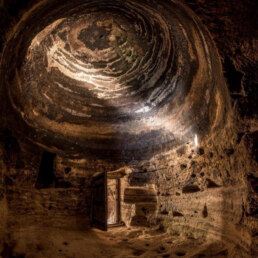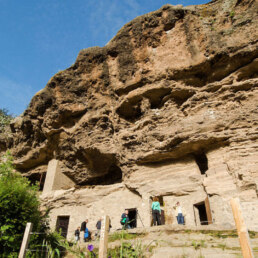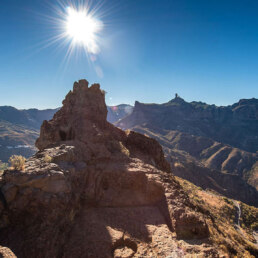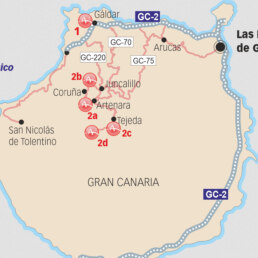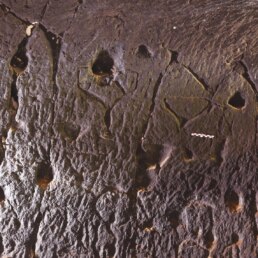RISCO CAIDO
Risco Caido and the Sacred Mountains of Gran Canaria Cultural Landscape, Cannery Islands
1. Introduction – A Mountain Sanctuary Frozen in Time
Risco Caído, nestled high in the rugged interior of Gran Canaria, is far more than a collection of ancient caves carved into volcanic rock. It is a living testimony to the ingenuity and spirituality of the island’s pre-Hispanic inhabitants, the Canarii people, who developed a sophisticated culture in isolation for over a millennium. Declared a UNESCO World Heritage Site in 2019, Risco Caído and the surrounding “Sacred Mountains of Gran Canaria” represent a cultural landscape where astronomy, agriculture, ritual life, and human adaptation to a harsh volcanic environment merged into one.
This vast archaeological and cultural complex stretches across some of the most dramatic mountain scenery in the Canary Islands. It is a place where nature dictated survival, where caves became temples, and where sunlight and moonlight were harnessed to mark the rhythm of the seasons.
2. The Setting – Geography and Natural Environment
Risco Caído is located in the mountainous heart of Gran Canaria, near the town of Artenara, at an altitude of over 1,200 meters. The protected cultural landscape spans nearly 18,000 hectares, with an additional 8,500-hectare buffer zone. It covers portions of the Caldera de Tejeda, the Tamadaba Natural Park, and the Parque Rural del Nublo, three of the island’s most scenic and biologically rich regions.
The landscape is a maze of deep ravines, sheer cliffs, volcanic escarpments, and pine-clad slopes. Ancient erosion has sculpted iconic rock formations such as Roque Nublo and Roque Bentayga, which tower over the valleys like stone sentinels. These natural features held sacred significance for the island’s early settlers, serving as landmarks for rituals and agricultural calendars.
The biodiversity of the region is equally impressive. Endemic flora such as the Canarian pine (Pinus canariensis), wild laurels, and juniper thrive alongside native herbs and shrubs used in traditional medicine. Raptors, kestrels, and small mammals make their home here, forming a delicate ecosystem that the ancient inhabitants respected and depended upon.
3. The People: The Canarii and Their Way of Life
The earliest settlers of Gran Canaria, known as the Canarii, were descended from Berber peoples of North Africa. Arriving sometime between the first and fifth centuries AD, they lived in almost complete isolation until the Spanish conquest in the late 15th century. This isolation allowed them to develop a distinct culture that combined African roots with adaptations unique to the island’s challenging volcanic terrain.
The Canarii were primarily farmers and herders. They cultivated cereals such as barley and wheat, used terraced agriculture to trap moisture, and domesticated goats and sheep. They also harvested wild plants, practiced careful water conservation, and built extensive granaries to store food for the dry season.
Their spiritual life revolved around the cycles of nature. Fertility rituals, ancestor worship, and astronomical observations played central roles in their religious practices. The mountains and caves were not just shelters; they were sacred spaces where life, death, and the cosmos were celebrated and interpreted.
4. A Troglodyte Civilization , Living in the Rock
Across the Risco Caído cultural landscape are more than 1,500 caves, both natural and human-made. These served multiple purposes:
• Habitation , Families lived in carved-out cave dwellings, often grouped into communities. These were cool in summer, warm in winter, and easy to defend.
• Granaries and storage , Specially cut chambers were used to store grains, cheese, and other foodstuffs, sealed with stone doors or wooden lids.
• Cisterns , Rainwater collection was essential, and many caves were designed to catch and store water.
• Burial sites , Rock-cut tombs and burial caves, often high on cliff faces, preserved the dead in dry conditions.
• Ritual spaces , Certain caves were clearly ceremonial, decorated with carvings, cup marks, and symbols.
Two of the most important ritual centers in the region are Risco Caído itself (particularly the cave known as C6) and the almogarén (temple) of Roque Bentayga. These were not mere dwellings but sacred places where the Canarii interpreted the will of the gods and the rhythm of the seasons.
5. The Astronomical Temple , Cave C6 at Risco Caído
The C6 cave is the crown jewel of Risco Caído. This artificial chamber, carved meticulously into volcanic tuff, has a unique parabolic domed ceiling , the only one of its kind in the Canary Islands. Its design was not accidental; it was carefully engineered to interact with sunlight and moonlight.
A small aperture in the roof acts as a solar and lunar projector. Here’s how it works:
• Spring and Autumn Equinoxes , The first ray of sunlight enters through the hole and projects onto the western wall, slowly illuminating the carvings.
• Summer Solstice , The sunlight sweeps fully across the wall, casting sharp light patterns on the engraved symbols.
• Winter Months , Moonlight, particularly from the full moon, takes over the role of marking time, creating similar patterns on the walls.
The wall itself is decorated with triangular and oval carvings, often interpreted as fertility symbols, possibly representing female pubic triangles or male phallic forms. Cup marks, grooves, and other engravings suggest ritual offerings.
This interplay of light and shadow formed a lunisolar calendar, used to regulate planting, harvesting, and possibly ritual festivals. It demonstrates an advanced understanding of the celestial cycles and their connection to agricultural success.
6. Religious and Cultural Significance
For the Canarii, the mountains were sacred. The word “almogarén” refers to ritual sites where priests or shamans conducted ceremonies to honor gods and ancestors. Fertility rites, offerings to deities of rain and sun, and initiation ceremonies likely took place inside caves such as C6.
The Sacred Mountains themselves , Roque Bentayga, Roque Nublo, Mesa de Acusa , were viewed as dwelling places of spirits. High places connected the people with the divine, while caves were seen as wombs of the Earth Mother, symbolizing life, death, and rebirth.
The fact that these rituals were linked to astronomical events underlines the Canarii’s sophisticated worldview. They saw time as a cycle governed by both terrestrial and cosmic forces.
7. Preservation and Modern Interpretation
Because of its fragile condition, the original C6 cave is not open to mass tourism. To protect it, authorities have created a high-tech replica at the Risco Caído Interpretation Centre in Artenara. This replica mimics the cave’s texture, carvings, and the exact light effects of the solstices and equinoxes.
Visitors can experience the light projections as they would have appeared to the Canarii priests, accompanied by detailed exhibitions, audiovisual presentations, and archaeological reconstructions of life in the mountains.
The broader landscape is accessible through hiking trails and guided tours, but conservation remains a priority. UNESCO recognition has increased global awareness, but with that comes the challenge of balancing tourism with preservation.
8. Debates and Academic Controversies
While most archaeologists agree on the cultural and ritual importance of Risco Caído, its astronomical interpretation remains debated. Some scholars argue that:
• The alignment of light could be coincidental or exaggerated without precise measurements.
• There is limited published research confirming exact solstice and lunar correlations.
• Much of the current interpretation relies heavily on the pioneering work of Julio Cuenca, the archaeologist who first identified the light phenomenon.
Nevertheless, the cultural context , fertility symbols, agricultural cycles, and the Canarii’s reverence for celestial forces , strongly supports the idea of intentional design.
9. A Unique Cultural Landscape
Risco Caído is not an isolated site; it is part of a wider cultural landscape where natural features and human activity are inseparably linked. The designation as a “Cultural Landscape” by UNESCO reflects this. The landscape combines:
• Archaeology , The caves, granaries, and ritual sites.
• Agriculture , Ancient terrace farming systems still visible today.
• Natural Heritage , Endemic flora and fauna within protected natural parks.
• Living Culture , Local communities maintain traditions linked to ancient practices, such as seasonal festivals and herbal medicine.
10 Visiting Today , A Journey into the Past
The Interpretation Centre
Start at the Risco Caído Interpretation Centre in Artenara, where you can:
• View the replica cave and witness the light phenomena.
• Study interactive panels, maps, and 3D models.
• Learn about Canarii agricultural and spiritual life.
Hiking and Sacred Mountains
Adventurous visitors can hike trails around Roque Bentayga and Roque Nublo, experiencing the dramatic volcanic scenery that shaped Canarii beliefs.
Best Time to Visit
The highlands are cooler than the coast. Spring (March-May) and autumn (September-November) offer clear skies and comfortable temperatures. However, if you time your visit with an equinox or solstice event, you may witness the same light phenomenon recreated at the Interpretation Centre.
,
CANARY ISLANDS DIGITAL CHARTS
CANARY ISLANDS DIGITAL CHARTS IN MBTILES FORMAT
AHOY !
... join the Ocean Posse to gain access to THIS AND OTHER information >>
JOIN THE OCEAN POSSE _FOR ACCESS TO THIS AND OTHER INFORMATION - SIGN UP HERE >>
ALREADY SIGNED UP ? FOLLOW THIS LINK TO LOGIN >>
The Ocean Posse offers many saving benefits in addition to validate information by fellow yacht owners >>
BENEFITS OF of joining the Ocean Posse
SAVE TIME - SAVE MONEY - and get the best and most up to date INFORMATION !
| BENEFITS FOR YOU, YOUR YACHT & YOUR CREW |
|
|
| PRE SEASON | IN SEASON | |
| ✔️ Up to date and verified information by fellow yachts | ✔️ | ✔️ |
| 📊 Communications focused on facts, not opinions or unsolicited advice | ✔️ | |
| 💰 Save real money at 70+ Marinas with discounts * | ✔️ ( June ) | ✔️ |
| 🛰️ Free vessel and fleet tracking courtesy of Predict Wind | ✔️ | |
| 🚩 Free Burgee | ✔️ | |
| 💰 Save with service providers and chandleries | ✔️ ( June ish ) | ✔️ |
| 🕵️ dedicated, experienced and discounted Canal and clearing in agents | ✔️ | ✔️ |
| 🗺️ Free aid to navigation 150 Gb OpenCPN satellite charts (mac/pc/android) | ✔️ immediately | ✔️ |
| 💰 Save Money on parts with a Westmarine Pro Discount | ✔️ | |
| 💰 Save Money with a Predict Wind Pro Discount | ✔️ | |
| 🗺️ Free Printable Reference Charts emergency backup to your electronics | ✔️ immediately | ✔️ |
| 📹 Free Video Seminars on destinations from those who are there | ✔️ immediately | ✔️ |
| 🌩️ Top weather routing avail by Marine Weather Center Chris Parker | ✔️ | |
| ⛵ Community of voyagers all are welcome, kids, single-handers, pets | ✔️ | ✔️ |
| ⚓ Peer support in emergencies with escalation procedures | ✔️ | |
| 🛈 Fleet Updates via email – free | ✔️ Prior Fleet immediately | ✔️ |
| 🏆 Fun Award Categories | ✔️ | |
| 📍 Free access to GOOD NAUTICAL Anchorage reports | ✔immediately | ✔️ |
| ☎️ Free Weekly live calls on Mondays via dedicated LINE.me group | ✔️ | |
| 💬 Free 24/7 LINE group channel | ✔️end of June | ✔️ |
| 🌊 Benefit from the latest information and prior experience participants | ✔️ | |
| 🔭 Be part of a fleet of sensor for those who come behind you or meet | ✔️ | |
| 🚷 Always priority traffic – for participants by participants | ✔️ |
- (* as long as you do not have prior contracts or reservations in place and of course subject to a marina’s availability the longer you stay the more discount the marina may give you )
If this is agreeable you can sign up now >>
THE ABOVE FILES ARE FOR LOGGED IN USERS ONLY


